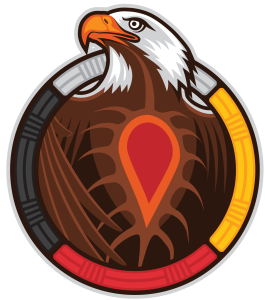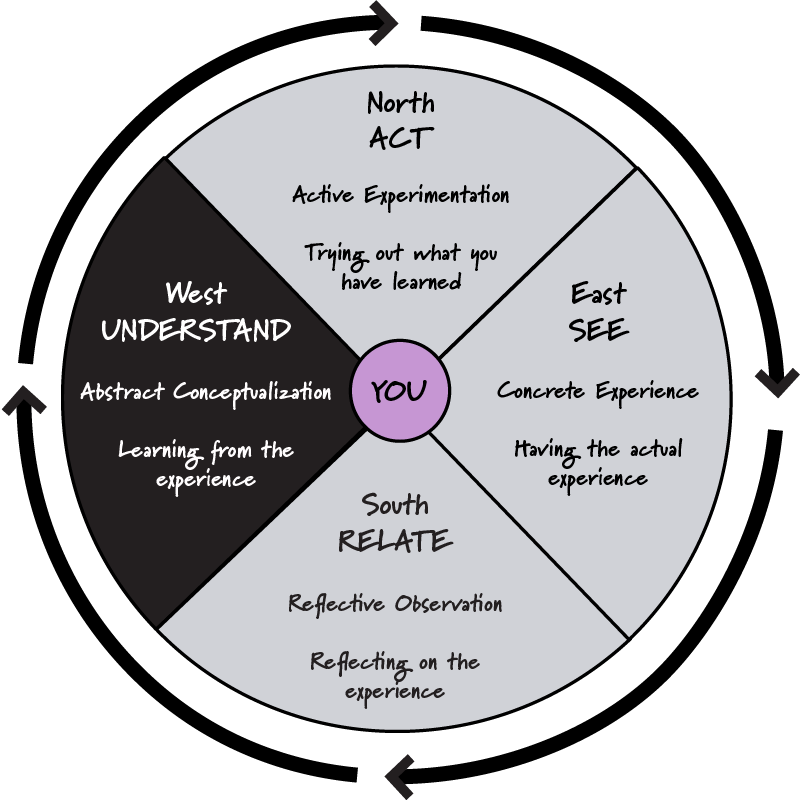
In Connection 3, you will learn how Wiidooktaadyang represents a strong demonstration of self-determination by Nipissing First Nation.
THE WEST: UNDERSTANDING THE THEORY BEHIND THE EXPERIENCE
You will begin Connection 3 in the West where you will learn about and understand existing health care provision from the Federal Government’s perspective and how Nipissing First Nation’s Wiidooktaadyang challenges this as an act of self-determination. You will conclude this section with a Reflection Checkpoint exercise.

Links to the First Nations Mental Wellness Continuum Framework
The concepts of community ownership, collaboration, and self-determination have direct links to mental wellness as indicated in the First Nations Mental Wellness Continuum Framework that we explored in Module 1, Connection 6![]() .
.

Specifically, the sixth (blue) ring from the center indicates self-determination and governance as elements supporting both the health system and First Nation wellness.
“First Nations control of services … community development, ownership, and capacity building are significant factors which must be taken into account in enhancing First Nations mental wellness. For example, community ownership of local programs and infrastructure can have a positive impact on wellness” (Thunderbird Foundation, 2022, p. 6).
Wiidooktaadyang is Self-Determination
In this video [5:11] NFN Psychologist, Dr. Brenda Restoule speaks about the links to the First Nation Mental Wellness Continuum Framework and the work of NFN’s Wiidooktaadyang. She addresses how the Wiidooktaadyang approach brings NFN program managers to work together and to be accommodating, especially when NFN does not have the required resources. She shares how this shift in management style to being more collaborative has had success on very different terms.
Video Transcript: Wiidooktaadyang is Self-Determination [Doc]![]()
Key Messages from the Video
- Collaboration and partnership are essential to Wiidooktaadyang as not every service is available within NFN
- By coming together NFN managers can partner and collaborate on solutions which might include cost-sharing to meet the unique needs of Nbisiing Debendaagziwaad
- New policies could be created, or they could advocate back to the Federal Government to provide better funding equity
- Community ownership is reflected in NFN taking the initiative to develop Wiidooktaadyang and to move away from colonial interpretations of service delivery
- Linking to outside services or agencies also fosters relationships for Nbisiing Debendaagziwaad
Two relevant links to the First Nations Mental Wellness Continuum Framework addressed by Dr. Restoule in the video are:
1. Community Development, Ownership and Capacity Building
“Community development, ownership, and capacity building are significant factors which must be taken into account in enhancing First Nations mental wellness. For example, community experience and research have demonstrated the positive impact that community ownership of local programs and infrastructure can have on First Nations mental wellness. Community development, ownership, and capacity building will play a key role in ensuring that the continuum of mental wellness programs and services for First Nations are relevant, effective, and meet community needs” (Thunderbird Foundation, 2015, p. 6).
NFN has taken ownership in developing Wiidooktaadyang and has built capacity by ensuring that all staff are trained on the Wiidooktaadyang model, and this ensures a competent approach to service delivery that is grounded in NFN culture and values.
2. Collaboration with Partners
“Enhancing First Nations mental wellness requires strategic action that goes beyond the mandate of the First Nations and Inuit Health Branch. It involves other federal government departments, provincial and territorial governments, and First Nations communities and requires supports and services that cross the health, justice, employment, and social service sectors. These partners must work collaboratively and cooperatively to ensure that a coordinated, comprehensive continuum of mental wellness services is available to those who require it. Currently, although it is recognized that there are shared roles and responsibilities, these roles and responsibilities are not always clear” (Thunderbird Foundation, 2015, p. 7).
NFN recognizes that not all the services required by Nbisiing Debendaagziwaad are available within the community. Linking to other service providers builds relationships for better service delivery at NFN. Wiidooktaadyang is also an excellent example of several department sectors working collaboratively to solve problems and to close gaps in service delivery.
Checkpoint 4: Read and Reflect
Click on the link to read the 2022 article entitled “Indigenous Healthcare in Canada” by Katalina Toth.: https://hir.harvard.edu/indigenous-healthcare-in-canada/![]()
In the article the author states that the “Western biomedical model takes a more individualistic perspective that focuses on patients as singular medical cases” (Toth, 2022). Think about what you learned about Wiidooktaadyang and Nipissing First Nation’s community-driven model of service delivery.
How does the Wiidooktaadyang model differ from the Western biomedical model? Download a copy of your notes before proceeding on in the micro-credential.
The author also points out that the gaps between Indigenous and non-Indigenous peoples’ health are a result of colonial practices like the Canada Health Act.
The Canada Health Act “outlines the goals and responsibilities of Canadian healthcare” and places great emphasis on treating and preventing sickness and disease.
How does Wiidooktaadyang go beyond Canada Health Act’s goals of treating and preventing sickness and disease? Download a copy of your notes before proceeding on in the micro-credential.
Connection 3 Summary
In Connection 3, we learned:
- Wiidooktaadyang is NFN’s demonstration of self-determination
- Community ownership, collaboration, partnership, and self-determination are elements of both Wiidooktaadyang and the First Nations Mental Wellness Continuum Framework
- Through Wiidooktaadyang, NFN Managers can work collaboratively to come up with creative solutions that move away from colonial interpretations of healthcare and siloed policies
- When services are not available at NFN, relationships can be developed with outside services and agencies to meet the needs of Nbisiing Debendaagziwaad

To move on to the Finish Point for Module 3, click on the “Next: Finish Point: Learning Scenario →” button at the bottom right hand corner of this page.
References
Nipissing First Nation. (2017, April). Wiidooktaadyang: We are helping one another: A holistic community services approach [Resource manual].
Thunderbird Partnership Foundation. (2015). First Nations mental wellness continuum framework. https://thunderbirdpf.org/fnmwc/![]()
Thunderbird Partnership Foundation. (2022). First Nations mental wellness continuum framework. https://thunderbirdpf.org/fnmwc/![]()
Toth, K. (2022, March 4). Indigenous healthcare in Canada. Harvard International Review. https://hir.harvard.edu/indigenous-healthcare-in-canada/![]()

